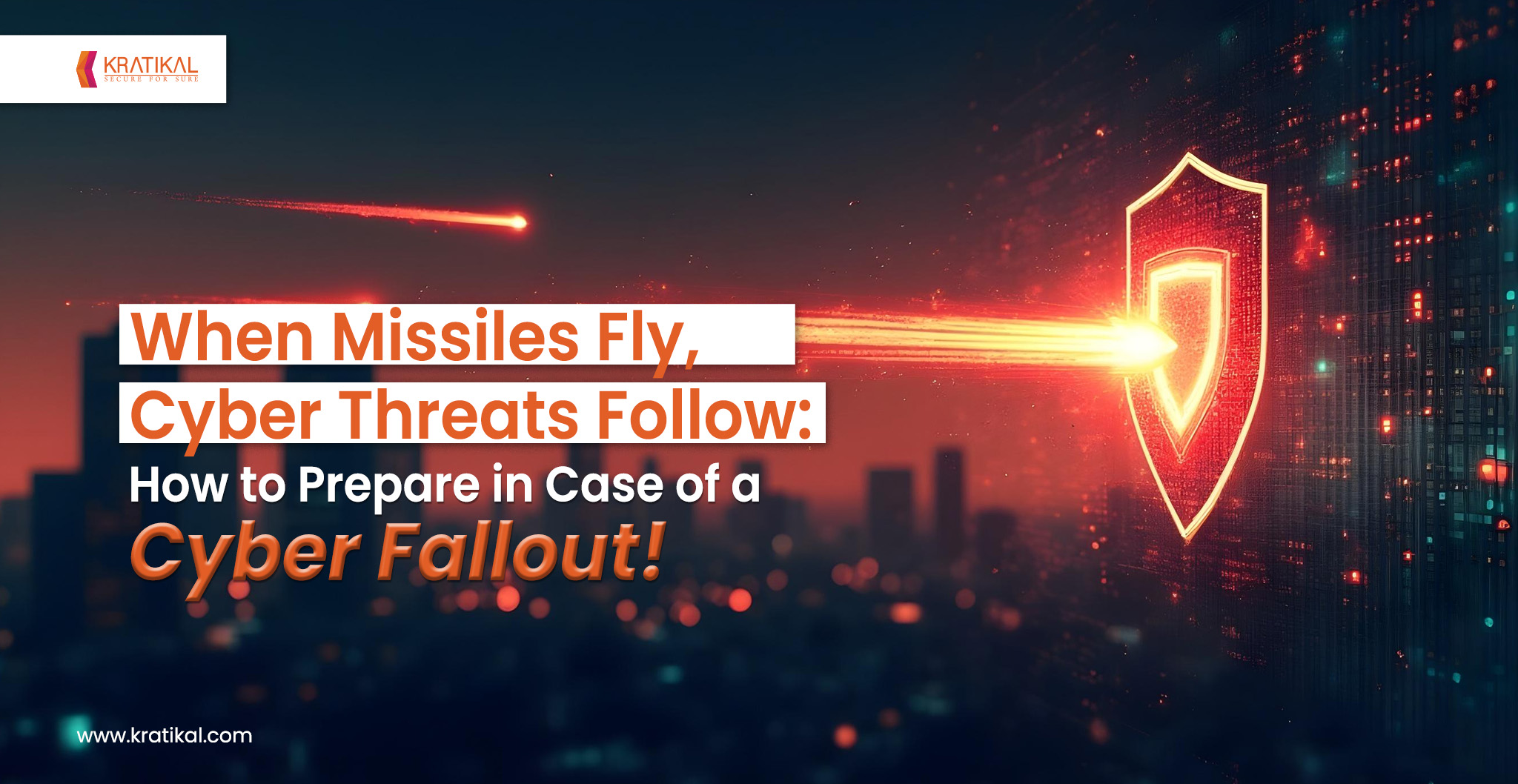Are we truly prepared for what’s coming? Amidst the ongoing geopolitical tensions and the risk of a full-scale conflict, every organization must ask itself this question. In an era where cyberattacks often accompany geopolitical unrest, the need for vigilance has never been greater, especially in regions like India’s key technical hubs, Bengaluru, Hyderabad, Chennai, Pune, Delhi NCR, Mumbai, and Kolkata. It is no longer enough for businesses to simply react when the probability of a cyber fallout is the maximum.
“Operation Sindoor” gave us time! A crucial time to prepare ourselves for the threats of tomorrow. Make the Right Move Today!
Remember, war doesn’t just happen on battlefields, it can hit your servers, your infrastructure, and your supply chains in an instant. To survive, organizations must think like they’re already under attack, ready with backup plans, strong cyber defenses, and the ability to keep running when everything else breaks down. Organizational leaders must actively demand briefings from their risk management, business continuity, crisis response, and cyber resilience teams to assess their readiness, particularly in areas where operations are within the conflict zones.
Table of Contents
Critical Role of BCP/DR, Penetration Testing, and RCA During Geo Political Tension
Cyber warfare is no longer a threat confined to dark corners of the internet, it has become a strategic weapon deployed during geopolitical tensions. In such an environment, organizations, regardless of size or industry, become vulnerable targets. The implications can be severe: prolonged downtime, financial loss, reputational damage, and in regulated industries, compliance violations. In this high-risk climate, the organizations that thrive are those that move from reactive defense to proactive resilience. Thus, they must be prepared to respond swiftly and decisively. Ensuring security and resilience in such times goes far beyond firewalls and antivirus software. It demands a comprehensive strategy focused on Business Continuity Planning (BCP), Disaster Recovery (DR), Root Cause Analysis (RCA), and Penetration Testing.
BCP/DR: The First Line of Organizational Defense from Cyber Fallout
A well-architected Business Continuity and Disaster Recovery (BCP/DR) strategy ensures that critical systems stay operational or can be quickly restored even in the face of a cyber fallout. What to do?
Regular Data Backups
The mainspring of any DR strategy is the ability to restore data. Organizations should maintain regular backups across multiple, geographically diverse locations, including off-site and cloud-based repositories. This ensures that even if one region or system is compromised, critical data can still be recovered.
Cloud-Based Disaster Recovery
Cloud platforms provide unmatched scalability and speed when it comes to disaster recovery. In times of crisis, organizations can rely on cloud-based environments, enabling rapid recovery of systems with minimal data loss or downtime.
Systems in Multiple Locations with Real-Time Data Backup
Establish redundant systems in different physical locations and enable real-time data replication across environments. This ensures business continuity if one site becomes unavailable due to an attack or collateral damage from geopolitical fallout.
Automated Failover Mechanisms
Human error and delays during crises can be costly. Automated failover systems allow for seamless switching to backup infrastructure, reducing response time and maintaining operational flow without requiring manual intervention.
Strengthened Cybersecurity Controls
BCP/DR is not only about restoring data, it’s also about protecting it. Implement multi-layered cybersecurity measures, from intrusion detection systems and endpoint protection to proactive threat intelligence and network segmentation.
Regular Testing and Emergency Drills
A plan on paper isn’t enough. Organizations must test their BCP/DR strategies through simulations and drills, identifying gaps and ensuring every stakeholder understands their role when disaster strikes.
Crisis Communication Plans
Silence during a crisis can erode stakeholder trust. Clear communication protocols ensure that employees, customers, and partners are informed during an incident, fostering confidence and reducing misinformation.
With these measures in place, organizations can mitigate the risk of operational paralysis in times of geopolitical turmoil.
Root Cause Analysis (RCA): Learning from Every Incident
While disaster recovery helps you bounce back, Root Cause Analysis (RCA) ensures you don’t fall victim to the same incident twice, especially at times of cyber fallout. When a cyberattack or data breach occurs, patching the symptoms isn’t enough. Organizations must dig deep to understand how and why the incident happened. RCA involves tracing the origin of the incident, whether it was a misconfigured firewall, an unpatched vulnerability, or insider negligence, and implementing lasting corrective actions.
Here’s How Kratikal Performs RCA
#1 Immediate Response:
Kratikal’s first priority is to quickly stop any ongoing attack. Our team takes fast action to reduce the impact and prevent further damage.
#2 In-Depth Investigation:
We carefully study the structure of your organization’s infrastructure to understand how the threat occurred. Key vulnerabilities are identified and prioritized especially in critical applications, to assess where the biggest risks lie.
#3 Detailed Reporting:
Every step of the investigation is recorded, from the first response to the discovery of threat indicators. Our reports give a clear, big-picture view of how the attack happened and unfolded over time.
#4 Actionable Recommendations:
Our analysis doesn’t stop at finding the problem. We provide clear, customized solutions to prevent similar attacks in the future, based on the specific weaknesses we uncovered.
Penetration Testing: Proactive Defense Against Evolving Threats
If RCA is the rear-view mirror, penetration testing is the high-beam headlight, illuminating hidden threats before they become incidents. In times of geopolitical instability, cyberattack vectors evolve rapidly. Organizations can’t afford to be blindsided. Penetration testing emulates real-world attacks to uncover:
- Exploitable vulnerabilities in web and mobile applications, networks, and other infrastructures
- Misconfigurations in cloud infrastructure
- Gaps in access controls and endpoint protection
- Weaknesses in third-party integrations and APIs
By adopting a red team mindset, penetration testers mimic the tactics, techniques, and procedures (TTPs) of actual threat actors, offering organizations a realistic view of their security posture and insightful recommendations.
Here’s How Kratikal Performs Penetration Testing
#1 Information Gathering:
This stage involves acquiring detailed information about the devices, network architecture, and protocols used.
#2 Planning-Analysis:
This stage involves devising a strategy to emulate a real-time threat scenario on the infrastructure. We have an exhaustive set of test cases to run on any target environment against which the target is tested. Plans are devised to optimise the entire process and minimise any adverse effect on live infrastructure.
#3 Vulnerability Detection:
In this phase, we run our tests on respective elements of the IT infrastructure with the help of industry benchmark tools. We list out the potential vulnerabilities against each device.
#4 Penetration Testing:
Out of all the potential vulnerabilities, a penetration test is carried out to identify the most probable attack points for the client. 80% of the VAPT work is done here. We write customized scripts as per the business logic and exploit each vulnerability manually for the best result.
#5 Reporting:
Once the penetration tests are over, we report all our findings to the client along with a detailed analysis of the vulnerability discovered, the threat level, the possible impact, recommendation strategies and proof of concepts (PoC).
#6 Report and Recommendation Discussion:
We generate concise reports of the vulnerabilities discovered, and we have a detailed discussion on the nature of the vulnerability, its impact, threat level, and recommendations with your development team to remove the vulnerability. Our technical experts discuss the report, along with the bugs found, and their impact scenario with the development team of the client. Comprehensive discussions are carried out on how to remove the vulnerabilities and secure the IT infrastructure.
#7 Patching by the Development Team of the Client:
The development team of the client patches all the vulnerabilities reported by Kratikal in discussion with the security team of Kratikal.
#8 Re-Testing:
In this step, Kratikal performs the re-testing of the IT infrastructure after the development team of the client gives the go-ahead and confirms that all the vulnerabilities have been patched.
How can you contact Kratikal?
Kratikal is a CERT-in Empanelled security auditor ready to help at this time of impending geo-political cyber danger or cyber fallout. When urgency strikes or need arises, your go-to contact at Kratikal is +91 92891 92210 or drop a mail at sales@kratikal.com.
or
Click on this link for our experts to contact you!








Leave a comment
Your email address will not be published. Required fields are marked *